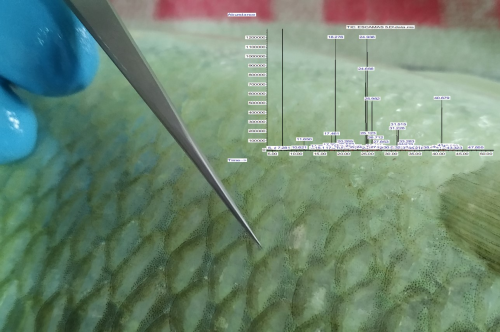An improved composition and nutritional traceability of fish at individual and population levels
Detail of the fish scale sampling, and fatty acids profile (bar chart).
Marine fatty acids, such as omega 3, are essential in human diets, and are mostly incorporated through fishes, so characterization of these fatty acids in fish fillet is of key importance in aquaculture as they determine the nutritional quality. The composition of fatty acids of fish is conditioned by the diet and can affect economic aspects such as price, as well as animal welfare. Current analysis methods are based on blood or tissue sampling, stressing the animal or even sacrificing it, therefore hindering representative monitoring both at population and individual levels.
With our new method, an estimation of the fatty acid profile of muscle is achieved through the analysis of fish scales, being, in addition to non- invasive, simple, cheap and quick, thus facilitating the sampling and tracking of animals and populations over time.
Main innovations and advantages
- Does not require to sacrifice or stress individuals as it only requires of a sample of scales.
- The sampling method is simpler and quicker than current ones, and does not require a special training
- Results can be obtained in a few hours.
- It has been successfully tested in gilt-head bream, European bass, turbot and salmon, both wild and cultured.
- In aquaculture, it can be used to determine the effect of diet on the fatty acid profile in each developmental stage, to guarantee the nutritional quality of the produced animals and maximize the output.
- Other application fields include food safety, research, and population ecology, among others.



